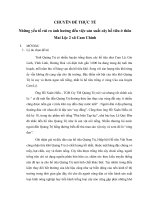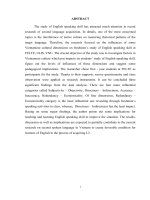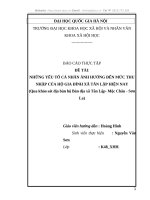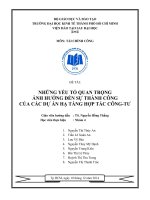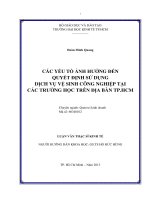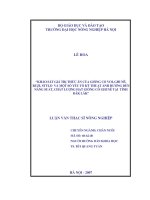Những yếu tố bên ngoài ảnh hưởng đến việc học từ vựng của học sinh lớp 10 tại một trường phổ thông ở hà nội
Bạn đang xem bản rút gọn của tài liệu. Xem và tải ngay bản đầy đủ của tài liệu tại đây (1.48 MB, 81 trang )
VIETNAM NATIONAL UNIVERSITY, HANOI
UNIVERSITY OF LANGUAGES AND INTERNATIONAL STUDIES
FACULTY OF POST-GRADUATE STUDIES
NGUYỄN THỊ HỒNG NHUNG
EXTERNAL FACTORS THAT AFFECT VOCABULARY
LEARNING OF GRADE 10 STUDENTS AT A HIGH SCHOOL
IN HANOI
(Những yếu tố bên ngoài ảnh hưởng đến việc học từ vựng
của học sinh lớp 10 tại một trường phổ thông ở Hà Nội)
M.A. MINOR THESIS
Field: English Teaching Methodology
Code: 8140231.01
Hanoi – 2018
VIETNAM NATIONAL UNIVERSITY, HANOI
UNIVERSITY OF LANGUAGES AND INTERNATIONAL STUDIES
FACULTY OF POST-GRADUATE STUDIES
NGUYỄN THỊ HỒNG NHUNG
EXTERNAL FACTORS THAT AFFECT VOCABULARY
LEARNING OF GRADE 10 STUDENTS AT A HIGH SCHOOL
IN HANOI
(Những yếu tố bên ngoài ảnh hưởng đến việc học từ vựng
của học sinh lớp 10 tại một trường phổ thông ở Hà Nội)
M.A. MINOR THESIS
Field: English Teaching Methodology
Code: 8140231.01
Supervisor: Dr. VŨ THỊ THANH NHÃ
Hanoi – 2018
DECLARATION
I hereby certify that the thesis entitled “External factors that affect vocabulary
learning of grade 10 students at a high school in Hanoi” is my own study in the
fulfillment of the requirement for the Degree of Master of Arts at Faculty of PostGraduate Studies, University of Languages and International Studies, Vietnam
National University, Hanoi.
Nguyễn Thị Hồng Nhung
Hanoi, 2018
i
ACKNOWLEDGEMENT
On completing this thesis, I would like to express my thanks to all those who
contributed their parts to the work of this research.
First and foremost, I would like to express my deepest thanks to my respectable
supervisor, Dr. Vũ Thị Thanh Nhã, for her restless and sympathetic encouragement,
constructive advice and patient guidance from the beginning up to the end of the
study. Had it not been for her valuable and timely feedback, I would have never
been able to complete this research paper.
My sincere thanks also go to my dear students at Ngoc Hoi high school for helping
me to collect data for this study and for all their support and encouragement.
Finally, I would also like to give my special thanks to my family and friends who
have been interminably encouraging and facilitating me to fulfill this thesis.
ii
ABSTRACT
Vocabulary learning is a crucial part of learning a second language. There have
been a number of researchers studying roles of vocabulary learning, approaches to
vocabulary and factors that affect vocabulary teaching and learning. Despite these
valuable sources of reference, there is still a lack of insight into external factors
affecting students‟ vocabulary learning in the context of Ngoc Hoi high school.
Besides, vocabulary learning of grade 10 students at this school is not very effective
in spite of both teachers‟ and students‟ efforts. Therefore, this study was conducted
to find out what external factors have the most and least influences on grade 10
students‟ vocabulary learning, and thus suggest some ways of improving the
effectiveness of vocabulary teaching and learning at this high school. This thesis is
a survey study. Questionnaire was used as the instrument to collect data for this
research. A Likert Scale questionnaire was developed on the basis of items which
refer to external factors affecting students‟ vocabulary learning; and SPSS program
was used to analyze the data collected. The study revealed that “teachers” is the
most influential factor, which is followed by English curriculum, Access to native
speakers, Number of exposures to the new words, and Peers. There is not enough
evidence to prove that Lexical factors have strong influences on students‟
vocabulary learning. It is expected that the findings of this study will not only
benefit teachers and students at this high school but also evoke further study.
iii
TABLE OF CONTENTS
PART I: INTRODUCTION .............................................................................................................................. 1
1.
2.
3.
4.
5.
RATIONALE FOR THE STUDY ............................................................................................................. 1
AIMS OF THE STUDY .......................................................................................................................... 2
RESEARCH QUESTIONS ...................................................................................................................... 3
SCOPE AND SIGNIFICANCE OF THE STUDY ........................................................................................ 3
ORGANIZATION OF THE THESIS ........................................................................................................ 3
PART II: DEVELOPMENT .............................................................................................................................. 5
CHAPTER 1: LITERATURE REVIEW ............................................................................................................... 6
VOCABULARY IN SECOND LANGUAGE LEARNING AND TEACHING ................................................... 6
1.1.
Definitions of vocabulary........................................................................................................ 6
1.2.
The importance of vocabulary in language teaching and learning ...................................... 7
1.3.
Aspects of knowing a word ..................................................................................................... 8
1.4.
Types of words and vocabulary learning .............................................................................. 10
1.5.
Approaches to vocabulary ..................................................................................................... 11
2.
FACTORS AFFECTING VOCABULARY ACQUISITION ........................................................................ 13
2.1.
Internal factors that affect vocabulary acquisition .............................................................. 13
2.2.
External factors that affect vocabulary acquisition ............................................................. 17
3.
VOCABULARY TEACHING TECHNIQUES .......................................................................................... 23
3.1. Deliberately teaching vocabulary .................................................................................................. 23
3.2. Some vocabulary teaching techniques .......................................................................................... 24
4.
SUMMARY ........................................................................................................................................ 26
1.
CHAPTER 2: METHODOLOGY .................................................................................................................... 27
1.
OVERVIEW OF THE METHOD USED IN THE STUDY .......................................................................................... 27
1.1. DEFINITION OF SURVEY RESEARCH........................................................................................................... 27
1.2. Rationale for using survey research ................................................................................................ 27
1.3. Strengths and limitations of survey research ................................................................................. 28
2.
SUBJECTS ............................................................................................................................................. 28
3.
DATA COLLECTION INSTRUMENTS ............................................................................................................. 28
3.1. Preparation ..................................................................................................................................... 28
3.2. Data collection ................................................................................................................................ 29
3.3. Techniques of data analysis ............................................................................................................ 30
CHAPTER 3: RESULTS AND DISCUSSION .................................................................................................... 31
1. QUESTIONNAIRE RESULTS .............................................................................................................................. 31
1.1. General information about the participants of the study ............................................................... 31
1.2. Reliability Statistics ......................................................................................................................... 34
1.3. Exploratory Factor Analysis (EFA)\ ................................................................................................. 41
1.4. Correlation analysis ........................................................................................................................ 45
1.5. Regression analysis ......................................................................................................................... 45
1.6. Descriptive statistics ....................................................................................................................... 48
2. DISCUSSION ................................................................................................................................................ 53
PART III: RECOMMENDATION AND CONCLUSION ..................................................................................... 55
1.
2.
SUMMARY OF MAJOR FINDINGS ...................................................................................................... 55
PEDAGOGICAL IMPLICATIONS ........................................................................................................ 57
2.1. Educational administrators ............................................................................................................ 57
2.2. Teachers ......................................................................................................................................... 57
2.3. Changing students’ learning attitudes ........................................................................................... 58
iv
3.
4.
LIMITATIONS OF THE STUDY ........................................................................................................... 58
RECOMMENDATIONS FOR FURTHER RESEARCH ............................................................................. 58
REFERENCES ............................................................................................................................................. 60
APPENDICES ............................................................................................................................................. 64
APPENDIX 1: QUESTIONNAIRE WRITTEN IN ENGLISH ................................................................................. 64
APPENDIX 2: QUESTIONNAIRE WRITTEN IN VIETNAMESE .......................................................................... 68
v
LIST OF ABBREVIATIONS
L2
Second Language
EFL
English as Foreign Language
EFA
Exploratory Factor Analysis
KMO Test
Kaiser-Meyer-Olkin Test
vi
LIST OF TABLES
Table/ Chart
Page
Table 1
Gender
31
Chart 1
Gender
31
Table 2
Age
31
Chart 2
Age
32
Table 3
Number of years of learning English
32
Chart 3
Number of years of learning English
32
Table 4
Score of English subject
33
Chart 4
Score of English subject
33
Table 5
Reliability Statistics – Factor C
34
Table 6
Item-Total Statistics – Factor C
34
Table 7
Reliability Statistics – Factor T (1st test)
34
Table 8
Item-Total Statistics – Factor T (1st test)
35
Table 9
Item-Total Statistics – Factor T (2nd test)
35
Table 10
Item-Total Statistics – Factor T (2nd test)
35
Table 11
Reliability Statistics – Factor E (1st test)
36
Table 12
Item-Total Statistics – Factor E (1st test)
36
Table 13
Reliability Statistics – Factor E (2nd test)
37
Table 14
Item-Total Statistics – Factor E (2nd test)
37
Table 15
Reliability Statistics – Factor P
37
Table 16
Item-Total Statistics – Factor P
38
Table 17
Reliability Statistics – Factor N
38
Table 18
Item-Total Statistics – factor N
38
Table 19
Reliability Statistics – Factor L
39
Table 20
Item-Total Statistics – Factor L
39
Table 21
Reliability Statistics – Factor V (1st test)
39
Table 22
Item-Total Statistics – Factor V (1st test)
40
vii
Table 23
Reliability Statistics – Factor V (2nd test)
40
Table 24
Item-Total Statistics – Factor V (2nd test)
40
Table 25
KMO and Bartlett's Test
41
Table 26
Results of EFA (independent variables)
42
Table 27
KMO and Bartlett's Test
43
Table 28
Results of EFA (dependent variables)
44
Table 29
Correlation coefficients
45
Table 30
Regression analysis
46
Table 31
Descriptive statistics – Factor C
48
Table 32
Descriptive statistics – Factor T
49
Table 33
Descriptive statistics – Factor E
50
Table 34
Descriptive statistics – Factor P
51
Table 35
Descriptive statistics – Factor N
51
Table 36
Descriptive statistics – Factor L
52
viii
PART I: INTRODUCTION
This chapter presents an overview of the study including rationale, aims of the
study, the research questions, the scope and significance of the study, and the outline
of the study.
1. Rationale for the study
Learning vocabulary is a very important part of learning a language. The more
words you know, the more you will be able to understand what you hear and read; and
the better you will be able to say what you want to when speaking or writing. In
learning a foreign language, vocabulary learning is an important part of the language
acquisition. It is one element that links the four skills of speaking, listening, reading
and writing all together. In order to communicate well in a foreign language, students
should acquire an adequate number of words and should know how to use them
accurately. Wilkins (1983) states that little can be conveyed without grammar but
nothing can be conveyed if there is no vocabulary. Besides, Folse (2008) also indicates
in an aricle that the level of vocabulary is a key factor for English language learners to
improve their second language proficiency. It can be said that a low level of
vocabulary is a major drawback for second language learners to master the language
both in communication and in academic learning. Therefore, how to make vocabulary
learning effective is always an issue that both second language teachers and learners
focus on.
In Vietnam, due to the importance of English, much efforts have been made in
teaching and learning English at schools and outside schools as well. English is one of
the core subjects in the National Curriculum set by the government and followed by
state primary and secondary schools. Moreover, English, together with Maths and
Literature, is compulsory in the national examination taken by grade 12 students at the
end of the school year. Schools, in general and secondary schools, in particular, follow
the national curriculum and syllabus. Thus, learning English at secondary schools is
learning reading, speaking, listening, writing, pronunciation and grammar. The
acquisition of English as the foreign language is significantly affected by students‟
vocabulary, so vocabulary teaching and learning is always an important part of every
1
English lesson no matter what the lesson is reading, speaking, listening or writing.
Facts have shown that students who have larger vocabulary are often better at these
four skills than those with poor vocabulary. However, Vietnamese students usually
feel bored in vocabulary lessons because they find it difficult to remember the spelling,
meaning, and grammatical function of the words.
In the case of the high school where the researcher is working, teachers often
spend five to seven minutes teaching vocabulary in reading, speaking, listening and
writing lessons. The time may be shorter or longer, depending on whether the topic of
the lesson is familiar to students or not. Each teacher has her own way of teaching
vocabulary and checking understanding. Besides some teachers who always try to use
different techniques in vocabulary teaching to attract students‟ interest, the others often
teach vocabulary by expliciting the words and their meanings. However, a lot of
students cannot remember the words and use the words later. As a result, if they have a
written test several days after the lesson, they cannot do well with questions related to
the vocabulary they learn before. In another situation, if teachers say something
containing the vocabulary taught before, students cannot understand or response to
teachers. In general, students‟ vocabulary learning is not very effective in spite of both
teachers‟ and students‟ efforts.
For all the reasons mentioned above, to find out the difficulties in learning
vocabulary of grade 10 students at a high school in Hanoi where the researcher is
working is necessary. Then, the external factors that most affect their vocabulary
learning can be identified. This will make it possible to give suggestions for the
teachers and learners to improve the teaching and learning of vocabulary at that high
school.
2. Aims of the study
The aims of this study are to find out what external factors affecting vocabulary
learning of grade 10 students at a high school in Hanoi and thus suggest some ways of
improving the effectiveness of vocabulary teaching and learning.
A theoretical framework for the study is focused on the second language
vocabulary learning, and factors affecting vocabulary acquisition.
2
3. Research questions
The study aims at finding out the most influential factors according to the
learners and what is the learners‟ need in terms of the materials and the methodology.
1. What are external factors affecting vocabulary learning of grade 10 students
at a high school in Hanoi?
2. What can be done to help the learners learn vocabulary better?
4. Scope and significance of the study
This study cannot cover all the aspects of needs analysis and course objectives.
The study limits itself to the investigation of some external factors affecting
vocabulary learning of grade 10 students at a high school in Hanoi where the
researcher is working.
The results should be interpreted within the high school teaching context. The
investigation primarily deals with reading in “Tiếng Anh 10” – the old book.
Practically, the findings are believed to be beneficial to vocabulary teaching and
learning of teachers and students especially grade 10 students at the school.
5. Organization of the thesis
This thesis consists of three parts as follows:
PART I, INTRODUCTION, provides general information about the context of
the research including theoretical point and personal need to conduct the study.
PART II, DEVELOPMENT includes the following chapters:
Chapter 1, LITERATURE REVIEW summarises some theories
concerning vocabulary in the second language teaching and learning, and
factors affecting vocabulary acquisition.
Chapter 2, METHODOLOGY, describes the methodology used in the
study including description, data collection instrument, subjects,
procedures, and data analysis.
Chapter 3, RESULTS AND DISCUSSION presents the data analysis
results and then provide the discussion on the results.
3
PART III, RECOMMENDATIONS AND CONCLUSION, presents a brief
summary of major findings, proposes some recommendations arising from the study,
states the limitations of the study and offers some suggestions for future research.
In addition, the study also includes the sections of REFERENCES which displays
the sources of referenced information and APPENDICES which presents the survey
questionnaire.
4
PART II: DEVELOPMENT
5
CHAPTER 1: LITERATURE REVIEW
1. Vocabulary in second language learning and teaching
1.1.
Definitions of vocabulary
Up to now, there have been different definitions of the term “vocabulary” due to
its various aspects, functions and contexts.
Neuman and Dwyer (2009, p. 385) define vocabulary as '' words we must know to
communicate effectively; words in speaking (expressive vocabulary) and words in
listening (receptive vocabulary)''.
Hornby (1995) defines vocabulary as a list of words with their meanings.
Burns (1972) defines vocabulary as the stock of words which is used by a person,
class or profession.
According to Zimmerman cited in Coady and Huckin (1998) vocabulary is central
to language and of critical importance to the typical language learning.
Penny Ur defines vocabulary as “the words we teach in the foreign language.
However, a new item of vocabulary may be more than a single word: a compound of
two or three words or multi-word idioms” (Ur, 1996:60). A similar definition from
Richards and Platt is that vocabulary is “a set of lexemes, including words, compound
words and idioms” (Richards & Platt, 1992: 400).
Benettayeb (2010) finds that vocabulary is the most amounts of words that
characterize a given language. Without this vocabulary, the learner would be unable to
use and comprehend the target language.
According to Lessard-Clouston (2013), vocabulary is implied as the words of a
language, including single items and phrases or chunks of several words which convey
a particular meaning. In other words, vocabulary not only addresses single lexical
items – words with specific meaning(s) – but it also includes lexical phrases or chunks.
With the above definitions, many researchers have established an overview of the
notion for vocabulary which is considered to be very important in language
acquisition. Thus, it is becoming increasingly apparent that teachers must enable
6
students to learn and acquire a lexical base in order for them to achieve success in
language learning. In summary, vocabulary is the certain number of words that a
speaker needs to convey his/her message.
1.2.
The importance of vocabulary in language teaching and learning
Vocabulary learning is considered a crucial part in second language learning.
Therefore, vocabulary is claimed to be one of the most important components in
learning a foreign language. According to Wilkins (1972), being able to create
sentences with correct grammar is valuable only when one has got adequate
vocabulary to express what he/ she wants to say. Wilkins also adds that speakers can
convey very little without grammar while they can convey nothing without
vocabulary. That means without vocabulary one can neither express his or her own
ideas nor understand others‟ ideas.
Schmitt (2000) also agrees that lexical knowledge is crucial in communication
and in the second language learning. Because of its important role, vocabulary is one
of the areas in L2 acquisition that a lot of researchers have had interest in from the late
1980s (Nation, 1990). There have been some researchers such as Laufer and Nation
(1999), Maximo (2000), Read (2000), who all agree that vocabulary acquisition is one
of the most important factors resulting in successful second language use. Besides,
Rivers and Nunan (1991), also state that if learners want to be successful in second
language use, they need to acquire an adequate vocabulary. That is because only when
learners have an extensive vocabulary can they have comprehensible communication
using the structures and functions they have learned before.
Richards (1980) and Krashen (1989), as cited in Maximo (2000) state reasons why
vocabulary needs to be paid special attention to when a learner studies a foreign
language. To be more detailed, the researchers state that to master a language, learners
need to acquire a large vocabulary. In fact, a number of second language learners often
bring along dictionaries because they realize that the lack of vocabulary will result in
many difficulties studying the language skills.
In addition, Nation (2011) supposes that learning vocabulary items plays an
integral part in all language skills: listening, speaking, reading, and writing. He also
7
describes the relationship between vocabulary knowledge and language use as
complementary: vocabulary knowledge enables language use and, language use also
leads to an increase in knowledge of vocabulary.
It has been proven that vocabulary knowledge has strong impacts on reading
comprehension through a foreign language; and the main and the largest obstacle that
L2 readers have to overcome is the lack of vocabulary (Huckin, 1995).
From their own research, researchers agree that a lack of vocabulary results in
both receptive and productive difficulties for learners. Therefore, learning vocabulary
is always a must for all L2 learners even those with high levels of language
competence and performance.
As stated by Laufer (1986), even when learners have mastered syntax, they still
think that their vocabulary is not good enough.
In summary, vocabulary learning is considered an important aspect of teaching
and learning a foreign language. It is also an area that learners are often unsure about
and find it hard to tackle. Therefore, second language vocabulary acquisition has
become an increasingly interesting topic of discussion for researchers, teachers,
curriculum designers, theorists, and others involved in second language learning and
teaching.
1.3.
Aspects of knowing a word
Penny Ur (1996) claims that when vocabulary is introduced to learners, what need
to be taught are form-written and spoken; grammar; collocation; aspects of meaning:
denotation, connotation, appropriateness, meaning relationships; and word formation.
According to Nation (1990) and Taylor (1990), knowing a word incorporates a large
amount of information. It involves not only knowing its spelling, morphology,
pronunciation, meaning, or the equivalent of the word in the learner‟s mother tongue
but also knowing its collocations, register, polysemy, and even its homonym.
There are different ways to define the concept of a word, but three significant
aspects which are form, meaning, and use need to be paid attention to.
8
Nation (2001) clarifies that the form of a word involves its pronunciation (spoken
form), spelling (written form), and any word parts that make up this particular item
(such as a prefix, root, and suffix).
Also stated by Nation (2001), meaning involves how form and meaning work
together. In other words, when one thinks of a word, what comes to his/her mind,
including the concept, its reference and associations, is called meaning.
The use of a word, according to Nation (2001), involves the grammatical functions
of the word or phrase, collocations that normally go with it, and finally any constraints
on its use, in terms of frequency, level, and so forth.
Nation (2001, p.27) also declares that there is both a receptive and productive
dimension for form, meaning, and use, which is summarized in the table below:
Aspect
Component
Receptive knowledge
Productive knowledge
Form
spoken
What does the word
How is the word
sound like?
pronounced?
What does the word look
How is the word written
like?
and spelled?
What parts are
What word parts are
recognizable in this
needed to express the
word?
meaning?
written
word parts
Meaning
form and meaning What meaning does this
What word form can be
word form signal?
used to express this
concepts and
What is included in this
meaning?
referents
concept?
What items can the
associations
What other words does
concept refer to?
this make people think
What other words could
of?
people use instead of this
one?
Use
grammatical
In what patterns does the
In what patterns must
functions
word occur?
people use this word?
collocations
What words or types of
What words or types of
9
words occur with this
words must people use
one?
with this one?
constraints on use
Where, when, and how
Where, when, and how
(register,
often would people
often can people use this
frequency...)
expect to meet this
word?
word?
1.4.
Types of words and vocabulary learning
There are 5 types of words and vocabulary learning according to Folse (2008)
Type 1: Single words
It is definite that learners need to know a certain number of words. According to
Schmitt (2000), a second language learner needs about 2,000 words to maintain
conversations, 3,000 word families to read authentic texts, and about 10,000 words to
comprehend challenging academic texts. The largest and mostly used typed of
words is single words.
Type 2: Set phrases
“Set phrases” refer to phrases which include more than one word, and speakers
cannot make a change of any word in these phrases.
Type 3: Variable phrases
Unlike set phrases, variable phrases consist of some components that can be
changed. The variation in variable phrases is often personal pronouns, possessive
adjectives, or word order.
Type 4: Phrasal verbs
A phrasal verb consists of a main verb and a particle. Some common verbs that can
form phrasal verbs are put, take, come, call, make, go, and get.
Type 5: Idioms
10
Each language has its own idiomatic expressions which are separate vocabulary
items. When a group of words has the meaning which is not formed by the meaning of
separate word in the group, then the group is called an idiom.
1.5.
Approaches to vocabulary
According to Boyle and Scanlon (2009), methods and techniques should be
combined in teaching vocabulary for there is no single method for teaching
vocabulary. Below are some principles belonging to inferring from context, implicit
teaching and explicit teaching, the three methods that are concerned by different
researchers.
Intentional learning of vocabulary
Intentional learning of vocabulary is a traditional and common method in
teaching vocabulary. Ellis (2001) calls it the planned method involving the use of tasks
designed to elicit forms which have been selected ahead by teachers. Although it will
provide the greatest chance of acquisition, it is time consuming and it is too laborious
for learners to learn the language. Moreover, intentional teaching of vocabulary in
classroom is often the teacher-centered class. In general, intentional learning of
vocabulary is the method of learning vocabulary by using tools to bring learners‟
attention into direct contact with the form and meaning of words, such as dictionaries,
vocabulary lists, and direct vocabulary explanation.
According to Hulstijn (2003), intentional learning occurs when learners are aware
that they will be tested at the end of an activity (e.g vocabulary). In other words,
learners are informed what activity they are going to perform, and what objectives that
need to be achieved by the end of the activity. Explicit vocabulary learning engages
learners in activities that focus attention primarily on vocabulary. According to Nation
(1990), intentional vocabulary learning occurs when learners do exercises and
activities that focus on vocabulary. Explicit vocabulary learning is of much important
in vocabulary acquisition. As stated by Decarrico (2001), without explicit vocabulary
learning, implicit vocabulary learning should not be applied for students with low and
intermediate levels.
11
Intentional learning is quick and usually preferred by learners, but it also causes
some problems. Learners often encounter vocabulary in an isolated form and remain
incapable of using it correctly in context. Hill (2005) quotes semantic errors from
students. For example, when students wrote “we lived (stayed) in a hotel for a week”,
they mistook “live” and “stay” because when they learned words, they only paid
attention to the forms and their Chinese equivalents but not collocation and
relationship among words. Thus, they put words in the wrong context. This illustrates
students‟ rely on memorization and neglect the semantic aspect of the language.
Incidental vocabulary learning
Incidental vocabulary learning can be defined as natural exposure to the
language through reading or listening in which the focus is on understanding the
meaning of the text, not the vocabulary.
Hulstijn (1996; cited in Gass, 1999) supposes that incidental learning is:
learning in the absence of an intention to learn. Hulstijn (2006) also considers
incidental learning the mode in which participants are not foretold about an upcoming
practice test for a particular type of information.
Other scholars also give different definitions of incidental learning. One of the
definitions presented by Schmidt (2000) is that, incidental learning is learning without
the intent to learn. Schmidt (2001) also states that incidental learning is definitely
passive in that it may occur when learners pay attention to some relevant features of
input.
Another definition is that, incidental vocabulary learning occurs through
multiple exposures to a word in different contexts (Huckin & Coady, 1999). Similarly,
Nation (2001) agrees that learners should be given multiple exposures to the word that
they are supposed to learn; and new words should be presented in contexts from which
learners can get the meaning.
From the definitions above, it can be seen that incidental vocabulary learning
occurs when the focus is not on vocabulary but elsewhere such as understanding a
written or spoken text.
12
There have been studies conducted to investigate the importance of incidental
vocabulary learning. Zimmerman (1997) states some strengths of incidental
vocabulary learning: (1) It gives learners a good sense of meaning and use of words
because it is contextualized; (2) It is efficient because it can help learners acquire
vocabulary and improve their reading skills at the same time; (3) It is more learnerbased because learners can select the reading materials themselves.
However, incidental vocabulary learning is beneficial if learners‟ vocabulary is
large like Mathew‟s effect: the rich become richer and the poor become poorer.
Therefore, intentional learning is pivotal for learners at the beginning level; and
incidental learning becomes practical if learners are at advanced level. Schmitt (2000)
declares that both explicit and incidental learning are necessary for second language
learners, and these two approaches of vocabulary should be seen as complementary.
Inferring from context
Belonging to the idea of Context Alone, “Inferring from Context”, also named
as context method, or contextual approaches is the method of using context to clarify
the meanings of the words that students need to learn. For instance, when students are
asked to guess the meaning of the words through one or some given sentences, they
are learning vocabulary by inferring the meaning of words from the context (Nagy,
1988). Graves (2006) suggests several principles of teaching vocabulary in context
method: Students should learn the words in meaningful contexts; Students should see
words in variety of contexts; Depth of meaning should be fostered; Learners should be
able to access the texts‟ meaning in the target language and learning a word involves
pronunciation, spelling, morphology and syntax.
2. Factors affecting vocabulary acquisition
2.1.
Internal factors that affect vocabulary acquisition
According to Felix (1977) as cited in Leontiev and James (1981:133), “Students
are the most important factor in learning an English vocabulary”. Internal factors are
those that an individual language learner brings with him or her to the particular
learning situation. In other words, they are the factors inside the students themselves.
13
According to Lightbown and Spada (1999), internal factors include age,
language aptitude, intelligence, attitude and motivation, personality. Similarly, Rubin
and Thomson (1994) suppose that the factors including age, aptitude, attitude,
personality, learning style and past experiences.
Age
In term of the influence of age on second language acquisition, Ellis (1994)
reports that learners who start learning a second language at early age often achieve a
more native-like accent than those who start late. Younger learners are quicker in
acquisition of phonology but not very successful in acquiring grammar. Motivated,
older learners can also be successful but they usually have difficulties achieving
native-speaker-equivalent pronunciation and intonation.
Personality
Learners‟ emotional states have a powerful influence on their behavior and
performance in the classroom and other learning situations. There are various theories
that claim that personality factors are important predictors of success in second
language learning. Personality traits such as extroversion, introversion, risk-taking,
independence and empathy have been the basis of discussions and disputes relating to
this topic (Ellis 1986). Theorists such as Guiora, Brannon and Dull (1972) have
considered empathy to be important; and Krashen (1981) argues that an out-going
personality contributes to language learning (Ellis, 1986). Research, such as that done
by Krashen (1981), has found that introverts generally perform better academically
whereas an extrovert appears more likely to take advantage of social opportunities for
second language input (Coleman & Klapper, 2005). Despite these theories, the
available research does not demonstrate a clearly defined effect on second language
learning. Rather, we all have different and unique personalities and each personality
trait can affect our second language learning in different ways (Ellis, 1986).
In summary, extroverted learners are better at acquiring a second language than
introverted or anxious learners. In other words, introverts usually make slower
progress, especially in the improvement of oral skills. That is because they are afraid
of making mistakes, and they tend to avoid opportunities to speak. As a result, the lack
14
of practice will make them less likely to fully acquire the second language vocabulary.
In contrast, extroverted learners are aware that making mistakes is inevitable, so they
are always willing to speak without fear of making mistakes. These learners dare to
take risks, so they have a lot more practice in comparison with the introverted learners.
Motivation (Intrinsic)
The social psychological factor of motivation has been proven to account for
differential success in second language learning. A motivated student can be defined
as someone who: “Expends effort, is persistent and attentive to the tasks at hand, has
goals, desires and aspirations, enjoys the activity, makes attributions concerning
success or failure, is aroused and make use of strategies to aid in achieving goals”
(Dornyei 2003, p.173). It makes sense that those individuals who are motivated to
learn the second language will learn faster and to a greater degree than those who are
not. This is supported by Reece and Walker (1997). They stress that a less able student
who is highly motivated can achieve greater success than the more intelligent student
who is not well motivated. It is very difficult to teach a second language in a learning
environment if the learner does not have a desire to learn a language.
Second language intrinsic motivation is defined as the interest in learning a
language for its own sake, without any external pressure.
According to Noels (2000), there are three types of intrinsic motivation that are
knowledge, accomplishment and stimulation. Intrinsic motivation is consider having a
strong relation with educational achievement. Having intrinsic motivation, learners
will learn to achieve competence in the language. Absolutely, those who enjoy
language learning and are proud of their progress will do better than students who
enjoy language learning and take pride in their progress will do better than those who
don't. According to Medford and McGeown (2012), in almost classrooms, learners
who are just beginning to learn a language are often highly motivated on their first few
classes or lessons and they enjoy their learning much.
Experiences
According to Lightbown and Spada (2013), it is easier for those who have
acquired general knowledge and experience to develop a new language. For instance,
15

